The Surface 3 Review
by Brett Howse on May 4, 2015 9:00 AM ESTDisplay
When Surface Pro 3 moved to a 3:2 aspect ratio, it made a lot of sense. 16:9 in a tablet makes for a very poor experience, and in a laptop, it is not much better. Almost everyone has moved to 16:9 in the laptop space and the lack of vertical height can make for a less than ideal experience. Most web content is vertical, and working in Office means you want vertical space as well. The widescreen does help with two windows snapped open at once, but I always find myself craving more vertical room.
On a tablet, I feel that 16:9 is even worse. Holding a 16:9 device in one hand can feel very heavy due to the length of the tablet, and turning it to portrait means that it is very tall and skinny. The move to 3:2 really squares up the device, and makes it a lot more balanced in either direction. Holding it in one hand is much easier, and finally portrait mode is usable on the Surface.
So the aspect ratio is a big improvement. The display size also has a slightly wider corner to corner of 10.8 inches versus 10.6 inch model that came before this. The actual width of the display is about 9 inches, compared to 9.2 on the outgoing Surface 2 model. The display height is now 6 inches, up from 5.2, so the total area of the display is almost 54 square inches, up from 48 inches on the outgoing model.
To fill this display, we have a Panasonic panel with a resolution of 1920x1280. This is roughly the same pixel density as the Surface Pro 3’s slightly larger 12 inch 2160x1440 display, coming in at 217 pixels per inch. It is not the highest PPI of a tablet, but it makes a good compromise between desktop and tablet use. Speaking of desktop use, I found that it makes a perfectly acceptable size for a small notebook, and even with touch it was not too difficult to work with the icons.
When Microsoft launched Surface 3, it said “with incredibly accurate colors and clarity from multiple viewing angles” and that would be excellent to see. The Surface Pro 3 has a decent display, but it was not the most accurate device we’ve tested.
To do our display testing, we use SpectraCal’s CalMAN 5 suite with a custom workflow. Brightness and contrast readings are taken with an X-Rite i1Display Pro colorimeter, and color accuracy is measured with an X-Rite i1Pro spectrophotometer. We target 200 nits brightness when doing our tests.
Brightness and Contrast
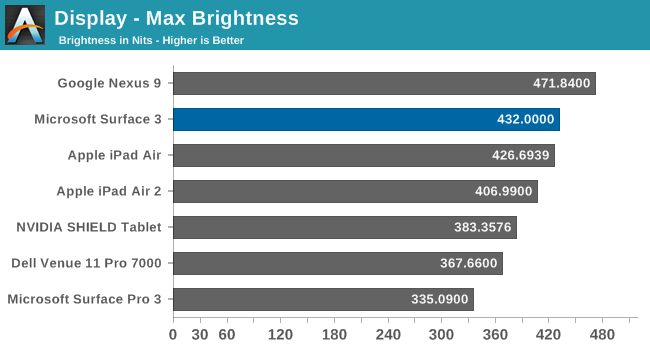
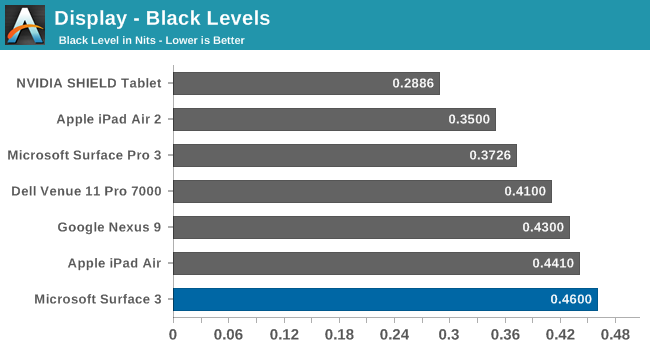
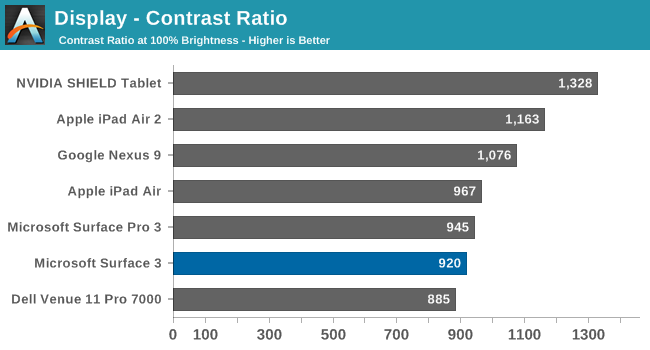
The Surface 3 gets quite bright, coming in at 432 nits at maximum output. The black levels are a bit high, but overall contrast is a decent 920:1. This makes the Surface 3 almost 100 nits higher than the Surface Pro 3 that Anand reviewed last year, which is a good start for this less expensive version.
Grayscale
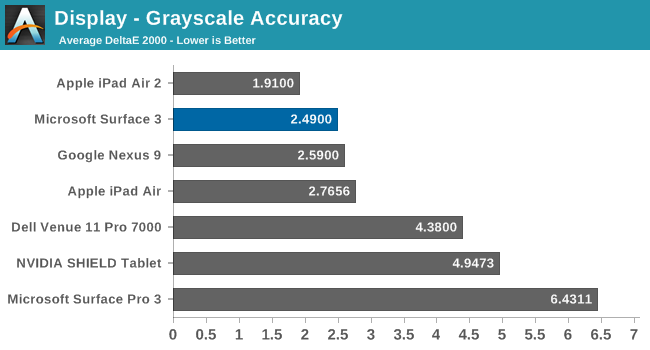
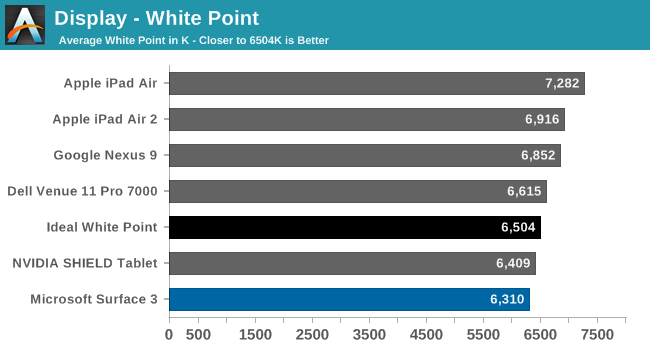
The grayscale average for the Surface 3 is very good, coming in just about at 2.5 as an average for the sweep. There is a bit of a spike at 25% but it is not indicative of the overall calibration. Gamma is a bit low, but the white point is fairly close to the ideal value.
Saturation
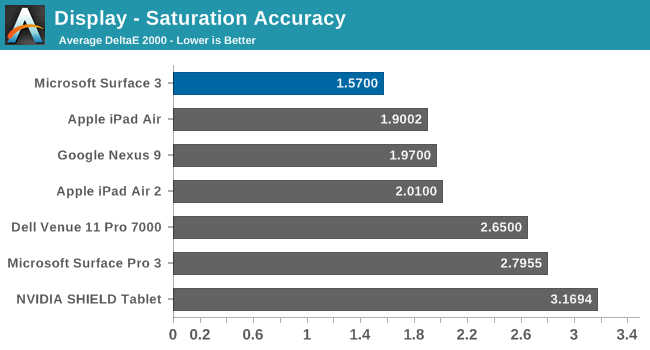
The accuracy on our saturation tests is outstanding, with an overall average score of just 1.57. Looking at the individual colors, the red is a bit oversaturated at 100%, and blue tends to be undersaturated, but the amount of error is very small.
Gamut and Gretag Macbeth
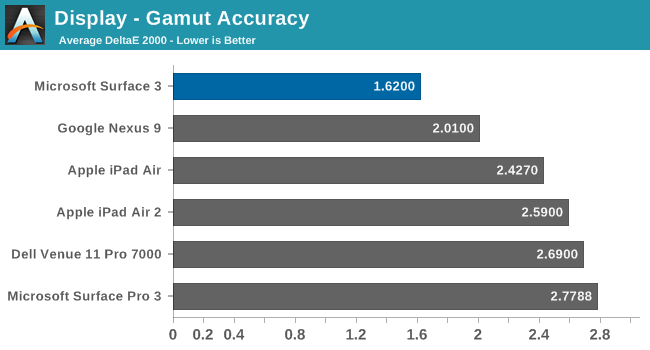
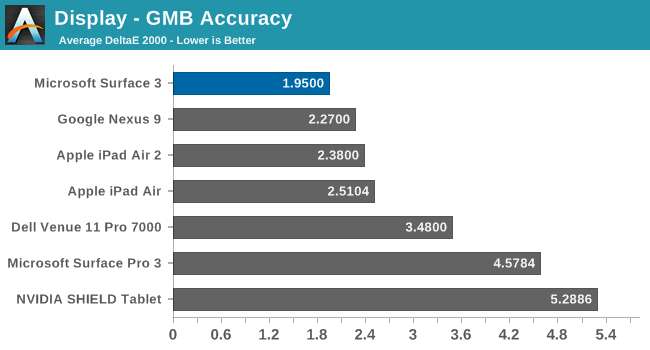
Once again the Surface 3 comes in with fantastic scores on these two tests, with the comprehensive GMB test under 2. When we are doing these tests, values under 3 are considered good, and the Surface 3 has passed with amazing scores. The best part of this is that all of this is done without the use of an ICC profile, so that means the hardware is being calibrated directly. ICC profiles can fix some issues, but not all programs respect them so having it done in hardware is a much better option.
Calibrated
Since this is a full x86 Windows operating system, we can also calibrate the display with the CalMAN software. Even though it was very good out of the box, the calibration pulls it even closer to perfection.
Surface 3 has one of the most accurate displays we have ever tested, which is great to see in what is considered the value member of the Surface family. Microsoft promised an accurate display and they have delivered.


















265 Comments
View All Comments
reynolds.jeff - Thursday, May 7, 2015 - link
Excellent, well thought out article. I'm tired of hearing how you "can't edit video" on the Surface 3. No kidding - it's not meant for that. You balanced the shortcomings with the benefits, and further cemented my desire to have one (saving up as we speak). Bravo to you and AnandTech!deiruch - Thursday, May 7, 2015 - link
Was the type-cover-no-longer-works-after-folding-it-back-problem solved with this iteration? Anand wrote in the SP3 review that it still had this problem. I noticed this problem in S1, S2, SP1, SP2 and SP3...Luc K - Thursday, May 7, 2015 - link
One thing worth mentioning with the USB connector is that you can use now an external power battery. It may charge slower but that could be an important feature for some as you can extend runtime bit longer.serendip - Friday, May 8, 2015 - link
This trick also works with smaller Windows tablets like the Dell Venue 8 Pro. With a 10k mAh battery pack, you can go for days without charging and the same pack can also charge phones.serendip - Friday, May 8, 2015 - link
2 GB RAM surprisingly works even for running Linux server VMs, although running a desktop like XFCE is a stretch. I think it's only for video and photo editing that you would need 4 GB, at which point you should be looking at a Surface Pro instead.plm2678 - Friday, May 8, 2015 - link
2GB and Win8 are not a good match. I agree it may work for certain Linux workloads. This is 2015 and memory is cheap.serendip - Saturday, May 9, 2015 - link
No, I meant it's possible to run Win8 *and* Linux VMs together on 2 GB RAM. 4 GB should be the minimum on these new tablets though.plm2678 - Friday, May 8, 2015 - link
Since when is 2GB a "decent spec"? Microsoft should be ashamed of the specs of the $499 model as only the $599 even begins to be acceptable.eanazag - Friday, May 8, 2015 - link
Okay; splain me this:How does the tablet light battery test use more juice than the notebook light test?
Surface 3 gets 7.8 hours of web browsing on the tablet test while getting 8.5 on the notebook test. How does that happen?
As far as the conclusion that was made it, it basically only puts the Surface 3 over the Surface Pro 3 in the tablet chart.
eliz82 - Monday, May 18, 2015 - link
so ... when the first phone with full windows? a 5.5-6inch 1280x720px phone with full windows 10 will be great.